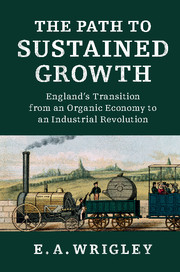 The Path to Sustained Growth
The Path to Sustained Growth Book contents
- Frontmatter
- Dedication
- Contents
- List of figures
- List of tables
- Acknowledgements
- Introduction
- 1 Organic economies
- 2 The classical economists
- 3 Energy consumption
- 4 Urban growth and agricultural productivity
- 5 Changing occupational structure and consumer demand
- 6 Demography and the economy
- 7 Transport
- 8 England in 1831
- 9 The completion of the industrial revolution
- 10 Review and reflection
- Bibliography
- Index
Introduction
Published online by Cambridge University Press: 05 January 2016
- Frontmatter
- Dedication
- Contents
- List of figures
- List of tables
- Acknowledgements
- Introduction
- 1 Organic economies
- 2 The classical economists
- 3 Energy consumption
- 4 Urban growth and agricultural productivity
- 5 Changing occupational structure and consumer demand
- 6 Demography and the economy
- 7 Transport
- 8 England in 1831
- 9 The completion of the industrial revolution
- 10 Review and reflection
- Bibliography
- Index
Summary
The object of this book is to describe the transformation in the capacity to produce goods and services which took place in England over a period of three centuries between the reigns of Elizabeth I and Victoria, and which is conventionally termed the industrial revolution. At the beginning of the period England was not one of the leading European economies. It was a deeply rural country where agricultural production was largely focused on local self-sufficiency. In part this was a function of the low level of urbanisation at the time. England was one of the least urbanised of European countries: the only large town was London. The market for any agricultural surplus was limited other than close to the capital city. There was therefore little inducement to undertake improvement. Industry was little developed compared with the situation in the more advanced continental countries. Across a wide range of products there was little or no domestic production. When an initiative was taken to create a domestic source of supply, it was often the case that foreign expertise was sought to enhance the chances of success. England was on the periphery of Europe economically as well as geographically. However, although other European economies were well in advance of England in the mid sixteenth century, all were subject to the limits to growth that were common to all organic economies.
The underlying constraint that prevented sustained growth in organic economies arose from the nature of its energy sources. All acts of material production, whether in the field, the forest, the workshop, or the household necessarily involved the expenditure of energy; and the same was true of all types of transport. But the quantum of energy that could be secured for these purposes was limited. It was based almost exclusively on the energy secured by the process of plant photosynthesis. The conversion of raw materials into finished products always involved the expenditure of either mechanical or heat energy, or both. The great bulk of the mechanical energy was provided by human or animal muscle power. This energy came from plant photosynthesis in the form of food or fodder. Wind and water power was of relatively slight importance. Heat energy was secured from burning wood or charcoal.
- Type
- Chapter
- Information
- The Path to Sustained GrowthEngland's Transition from an Organic Economy to an Industrial Revolution, pp. 1 - 6Publisher: Cambridge University PressPrint publication year: 2016


